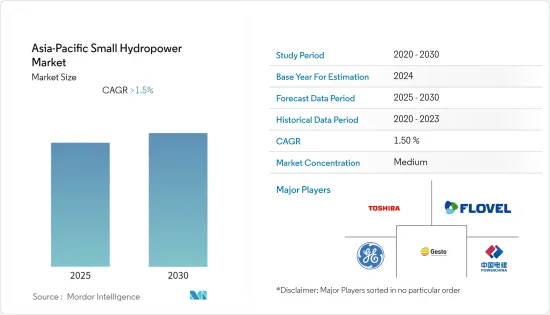
|
시장보고서
상품코드
1635522
아시아태평양의 소수력발전 시장 - 점유율 분석, 산업 동향과 통계, 성장 예측(2025-2030년)Asia-Pacific Small Hydropower - Market Share Analysis, Industry Trends & Statistics, Growth Forecasts (2025 - 2030) |
||||||
■ 보고서에 따라 최신 정보로 업데이트하여 보내드립니다. 배송일정은 문의해 주시기 바랍니다.
아시아태평양의 소수력발전 시장은 예측 기간 동안 1.5% 이상의 CAGR을 나타낼 것으로 예상됩니다.

시장은 2020년 COVID-19 팬데믹에 의해 부정적인 영향을 받았습니다. 현재 시장은 유행 이전 수준에 도달했습니다.
주요 하이라이트
- 중기적으로는 신뢰성이 높은 전력 수요 증가, 기후 변화에 대응한 재생가능·소수력발전 프로젝트에 대한 투자 증가, 시책이니셔티브 등의 요인이 예측기간 중 세계의 소수력발전 시장을 견인할 것으로 예상됩니다.
- 한편, 발전 에너지는 계절의 높낮이에 의존하기 때문에 불안정한 에너지 공급은 시장 성장의 방해가 될 것으로 예상되며, 예측 기간 중에는 소수력발전 설비의 억지력으로서 기능할 가능성이 있습니다.
- IoT와 수력발전의 통합과 농촌지역의 생활을 유지하기 위한 소수력발전댐에 대한 긍정적인 전망은 향후 수년간 세계 소수력발전시장에 큰 기회를 가져올 것으로 예상됩니다.
- 베트남은 소수력발전 개발에 있어서의 정부의 시책 등의 요인에 의해 예측 기간 중에 시장에서 큰 점유율을 차지할 것으로 예상된다,
아시아태평양의 소수력발전 시장 동향
1-10MW 부문이 시장을 독점할 것으로 예측
- 예측 기간 동안 시장 용량별로는 1-10MW 부문이 가장 많아질 것으로 예측됩니다. 농촌 전기화를 위해 전개되고 있는 소규모 분산형 프로젝트에 기인하고 있습니다.
- 국제재생가능에너지기구(IRENA)에 따르면 2021년에는 아시아태평양에서 이미 608.72GW의 수력발전용량이 있어 2020년(584.23GW)보다 4.1% 증가하고 있습니다.
- 소형 수력은 인도네시아의 농촌와 비전화전화에 있어 필수적인 역할을 하고 있습니다. 1992-2018년에 걸쳐 현지 NGO인 IBEKA는 수마트라, 자바, 칼리만탄, 술라웨시, 누사 툰가라에 65개의 SHP 플랜트를 건설했습니다.
- 이를 통해 인도네시아 전역에서 소규모 수력발전 프로젝트의 개발이 시작되었습니다. 또한 2021년 11월에는 Andritz Energy의 3.82MW×2기의 Cikaengan 2 미니 수력 발전소가 TOC(인계 증명서)의 취득에 성공했습니다.
- 인도에서는 누적 계통 연계 재생 가능 에너지 용량 175GW를 달성하는 전체 목표 아래, 2022년에 5GW의 소수력발전 용량을 달성하는 국가 목표를 설정하고 있습니다. 발전 프로젝트를 통해 2019년 말까지 467만kW의 소수력발전 용량을 도입하고 있습니다.
- 그 때문에 여러 지역 정부로부터의 지원이 증가하고 있어, SHP의 개발에는 큰 가능성이 있기 때문에 소수력발전 시장은 예측 기간 중에 큰 성장을 이룰 것으로 예상됩니다.
시장에서 큰 점유율을 차지하는 베트남
- 베트남은 동남아시아 최대의 수력발전시장 중 하나입니다.
- 전통적으로 수력 발전은 베트남의 총 발전량의 30.77%를 차지했으며 전통적으로 베트남 경제는 국내 수요를 충족시키기 위해 수력 발전에 크게 의존해 왔습니다. 국수 수요가 급증함에 따라 석탄 화력 발전의 비율이 증가하고 다른 재생 가능 에너지도 안정된 속도로 성장하고 있지만 총 발전량에서 차지하는 비율은 상대적으로 작아지고 있습니다.
- 베트남 정부가 재생 가능 에너지 용량을 개발함에 따라 향후 몇년이내에 13GW 이상의 설비가 베트남에 설치될 것으로 예상되고 있습니다. 2020-2025년까지 태양광 발전과 수력 발전 전기에 의해 지원 될 것으로 예상됩니다. 따라서 재생 가능 에너지 목표를 달성하고 에너지 부문을 개발하기 위해 정부는 다양한 수력 발전 프로젝트를 시작했으며 예측 기간 동안 시장 성장 를 지원할 것으로 기대되고 있습니다.
- IRENA에 따르면 2021년 아시아태평양의 수력 발전 용량은 이미 4,272만 kW로 2020년(3,837만 kW)보다 11.3% 증가하고 있습니다.
- 2021년에 발표된 전원 개발 계획 8(PDP8)에서는 2045년까지 재생 가능 에너지의 비율을 75%로 하는 것을 목표로 하고 있습니다. 2030년 5,000MW, 2045년 6,000MW 근처 하는 것을 목표로 하고 있습니다.정부는 전력 부문에 120억-130억 달러를 투자할 계획이며, 수력 발전은 총 설비 용량의 17.7%-19.5%를 차지하게 됩니다. 용량은 2030년까지 약 13만 370-14만 3,839MW가 됩니다.
- 2022년 4월, Flovel Energy는 수평 프랜시스 유닛을 갖춘 베트남의 Nam Tang 3HPP(8.75MW×2) 계약 체결을 발표했습니다. Truong Thanh Investment Construction Company Limited가 이 프로젝트를 개발하고 있습니다. Nam Tang 3 수력 발전 프로젝트는 베트남 예바이에 위치해, 이 회사에 있어서 동성에서 8번째의 프로젝트가 됩니다.
- 따라서, 상기 요인으로부터, 예측 기간중, 베트남은 아시아태평양의 소수력발전 시장에서 큰 점유율을 차지할 것으로 예상됩니다.
아시아태평양의 소수력발전 산업 개요
아시아태평양의 소수력발전 시장은 세분화되어 있습니다.
기타 혜택
- 엑셀 형식 시장 예측(ME) 시트
- 3개월간의 애널리스트 서포트
목차
제1장 서론
- 조사 범위
- 시장의 정의
- 조사의 전제
제2장 주요 요약
제3장 조사 방법
제4장 시장 개요
- 소개
- 설치 용량과 2027년까지의 예측(단위:GW)
- 최근 동향과 개발
- 정부의 규제와 시책
- 시장 역학
- 성장 촉진요인
- 억제요인
- 공급망 분석
- Porter's Five Forces 분석
- 공급기업의 협상력
- 소비자의 협상력
- 신규 진입업자의 위협
- 대체품의 위협
- 경쟁 기업간 경쟁 관계의 강도
제5장 시장 세분화
- 용량별
- 1MW 이하
- 1-10MW
- 용도별
- 전력 인프라
- 토목 공사
- 기타
- 지역별
- 중국
- 인도
- 일본
- 인도네시아
- 베트남
- 기타 아시아태평양
제6장 경쟁 구도
- M&A, 합작사업, 제휴, 협정
- 주요 기업의 전략
- 기업 프로파일
- Toshiba Energy Systems & Solutions Corporation
- FLOVEL Energy Private Limited
- Gesto-Energia SA
- General Electric Company
- Power Construction Corporation of China
- Andritz AG
- Siemens Energy AG
- Bharat Heavy Electricals Limited
- Voith GmbH & Co. KGaA
- Stantec Inc.
제7장 시장 기회와 앞으로의 동향
JHS 25.01.31The Asia-Pacific Small Hydropower Market is expected to register a CAGR of greater than 1.5% during the forecast period.

The market was negatively impacted by the COVID-19 pandemic in 2020. Presently, the market has reached pre-pandemic levels.
Key Highlights
- Over the medium term, factors such as the rising demand for reliable electricity, increasing investments for renewable and small hydropower projects in response to climate change, and policy initiatives are expected to drive the global small hydropower market during the forecast period.
- On the other hand, an unstable energy supply is expected to hinder market growth because the energy generated depends on seasonal highs and lows and can act as a deterrent for small hydropower installations during the forecast period.
- Nevertheless, the integration of IoT with hydropower and the positive outlook toward small hydropower dams to sustain lives in rural communities are expected to create significant opportunities for the global small hydropower market in the coming years.
- Vietnam is expected to have a significant share in the market during the forecast period due to factors such as government policies in developing small hydropower,
APAC Small Hydropower Market Trends
The 1-10 MW Segment Expected to Dominate the Market
- The 1-10 MW segment is projected to be the most abundant small hydropower plant type by capacity in the market during the forecast period. This higher share of 1-10 MW plants (almost 80%) can be attributed to the small-scale decentralized projects deployed in developing nations, especially in China, India, Japan, Indonesia, and Vietnam, for rural electrification.
- According to the International Renewable Energy Agency (IRENA), in 2021, there was already 608.72 GW of hydropower capacity in the Asia-Pacific region, which is 4.1% higher than in 2020 (584.23 GW).
- Small hydro plays an essential role in rural and off-grid electrification in Indonesia. By the end of 2020, 286 SHP plants and mini-grid with a range of capacity from 5 to 400 kW have been installed to provide people in rural areas with access to electricity. Additionally, during 1992-2018, IBEKA, a local NGO, constructed 65 SHP plants in Sumatera, Java, Kalimantan, Sulawesi, and Nusa Tenggara. These plants range between 0.5 and 170 kW, with a total installed capacity of 2,636 kW.
- This has kickstarted the development of several small-scale hydropower projects all over Indonesia. For instance, in August 2022, Andritz Energy commissioned the 3 x 1.748 MW Cikaengan 1 Mini Hydropower Plant in Garut, West Java. Additionally, in November 2021, Andritz Energy's 2 x 3.82 MW Cikaengan 2 mini hydropower plant successfully obtained the TOC (Taking Over Certificate).
- India has set a national target of achieving 5 GW of small hydropower capacity in 2022 under overall targets of achieving a cumulative grid-connected renewable energy capacity of 175 GW. The country has already installed 4.67 GW of small hydropower capacity by the end of 2019 through 1,127 small hydropower projects.
- Therefore, with increasing support from several regional governments and a huge potential for SHP to be developed, the small hydropower market is expected to witness significant growth during the forecast period.
Vietnam to have a Significant Share in the Market
- Vietnam is one of the largest hydropower markets in Southeast Asia. According to the Electricity Authority of Vietnam (EVN), as of 2022, Vietnam had 20.774 GW of hydropower, accounting for nearly 29.9% of the country's total installed capacity.
- Traditionally, hydropower has accounted for a significant share of the country's gross electricity generation mix, accounting for nearly 30.77% of the country's total electricity generation. Traditionally, the Vietnamese economy has relied heavily on hydroelectricity to satiate domestic demand. However, as domestic demand has increased rapidly, the share of coal-fired generation in electricity has grown, along with other renewables that have also grown at a steady pace but occupy a relatively smaller share of the total electricity generation mix.
- As the Vietnamese government develops renewable energy capacity, over 13 GW of installations is anticipated to be installed in Vietnam within the next few years. Around 70% of this renewable-led transition is expected to be supported by solar PV and hydropower by 2020-2025. Thus, to achieve the renewable energy target and to develop its energy sector, the government has initiated various hydropower projects, which are expected to support the market's growth during the forecast period.
- According to IRENA, in 2021, there was already 42.72 GW of hydropower capacity in the Asia-Pacific, which is 11.3% higher than in 2020 (38.37 GW).
- Power Development Plan 8 (PDP8), published in 2021, targets a share of 75% for renewable energy by 2045. The total capacity of small hydropower sources is targeted to reach 4,800 MW in 2025, 5,000 MW in 2030, and nearly 6,000 MW by 2045. The government plans to invest USD 12-13 billion in the power sector, and hydropower would account for 17.7% -19.5% of the total installed capacity. The total installed capacity for the whole power system will come to around 130,370-143,839 MW by 2030.
- In April 2022, Flovel Energy announced the signing of the contract for Nam Tang 3 HPP (2 x 8.75 MW) in Vietnam with Horizontal Francis units. Truong Thanh Investment Construction Company Limited is developing the project. Nam Tang 3 Hydro Project is located in Yen Bai Province, Vietnam, and is the company's eighth Project in the Yen Bai province.
- Therefore, based on the above-mentioned factors, Vietnam is expected to have a significant share in the Asia-Pacific small hydropower market during the forecast period.
APAC Small Hydropower Industry Overview
The Asia-Pacific small hydropower market is fragmented. Some of the key players in the market (in no particular order) include Toshiba Energy Systems & Solutions Corporation, FLOVEL Energy Private Limited, Gesto-Energia SA, General Electric Company, and Power Construction Corporation of China, among others.
Additional Benefits:
- The market estimate (ME) sheet in Excel format
- 3 months of analyst support
TABLE OF CONTENTS
1 INTRODUCTION
- 1.1 Scope of the Study
- 1.2 Market Definition
- 1.3 Study Assumptions
2 EXECUTIVE SUMMARY
3 RESEARCH METHODOLOGY
4 MARKET OVERVIEW
- 4.1 Introduction
- 4.2 Installed Capacity and Forecasts in GW, till 2027
- 4.3 Recent Trends and Developments
- 4.4 Government Policies and Regulations
- 4.5 Market Dynamics
- 4.5.1 Drivers
- 4.5.2 Restraints
- 4.6 Supply Chain Analysis
- 4.7 Porter's Five Forces Analysis
- 4.7.1 Bargaining Power of Suppliers
- 4.7.2 Bargaining Power of Consumers
- 4.7.3 Threat of New Entrants
- 4.7.4 Threat of Substitute Products and Services
- 4.7.5 Intensity of Competitive Rivalry
5 MARKET SEGMENTATION
- 5.1 By Capacity
- 5.1.1 Up to 1 MW
- 5.1.2 1-10 MW
- 5.2 By Application
- 5.2.1 Power Infrastructure
- 5.2.2 Civil Works
- 5.2.3 Other Applications
- 5.3 By Geography
- 5.3.1 China
- 5.3.2 India
- 5.3.3 Japan
- 5.3.4 Indonesia
- 5.3.5 Vietnam
- 5.3.6 Rest of Asia-Pacific
6 COMPETITIVE LANDSCAPE
- 6.1 Mergers and Acquisitions, Joint Ventures, Collaborations, and Agreements
- 6.2 Strategies Adopted by Leading Players
- 6.3 Company Profiles
- 6.3.1 Toshiba Energy Systems & Solutions Corporation
- 6.3.2 FLOVEL Energy Private Limited
- 6.3.3 Gesto-Energia SA
- 6.3.4 General Electric Company
- 6.3.5 Power Construction Corporation of China
- 6.3.6 Andritz AG
- 6.3.7 Siemens Energy AG
- 6.3.8 Bharat Heavy Electricals Limited
- 6.3.9 Voith GmbH & Co. KGaA
- 6.3.10 Stantec Inc.
7 MARKET OPPORTUNITIES AND FUTURE TRENDS
샘플 요청 목록



















